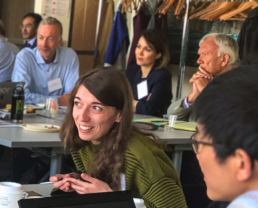24 May 2023 – Various stakeholders, from academics to industry, gathered in Vancouver for the Green Shipping Project partnership meeting to discuss ‘Governing Green Shipping Transformation: Pathways to Maritime Sustainability’. Andreea Miu, SSI’s head of decarbonisation, participated in a session on ‘Transforming the lifecycles of shipping, fuel, and infrastructure’.

Transforming lifecycles
‘Lifecycle phases’ are often categorised into pre-production, production, transportation, use, and end-of-life. The lifecycle of ships, materials, and infrastructure tend to have very long use phases – to the magnitude of decades – and the end-of-life treatment requires careful consideration of material waste hierarchies.
Embedding circularity and rethinking the use phase of ships and infrastructure can transform lifecycles. Reusing materials and extending the lifetime of a ship or infrastructure is a good starting point. Designing for modularity – where parts of a vessel can be refurbished and replaced – builds unto this by allowing materials to be reused and refurbished.
At end-of-life, recycling systems need to be re-evaluated to ensure that they are operating optimally and resources are used efficiently. Steel from ships is considered high quality, yet once a ship is dismantled, its steel ends up either being re-rolled or pooled together with scrap from other sources and melted. The resulting products usually being used in local/national industries. Thus, there is great potential to optimise resource efficiency within ship recycling.
Shipping needs to decarbonise in order to keep planetary warming to below 1.5°C. Using high-quality scrap steel to produce new high-quality steel could be a solution to decarbonising the lifecycles of assets and materials used in shipping, this reducing Scope 3 emissions.
Improving the collection and sorting of scrap steel and ensuring that shipping’s high-quality scrap steel is used for high quality applications is crucial to transforming the lifecycle of materials where ships and infrastructure are concerned. In addition to this, cross-sectoral collaboration on reducing steel emissions is necessary, as the steel sector is responsible for 7-9% of global carbon emissions.

Towards a sustainable, decarbonised shipping industry
Andreea was joined by joined Nicholas Schneider, director of environmental, social and corporate governance & projects at Teekay, and Eleanor Kirtley, senior program manager at Green Marine. Some key takeaways:
- Shipping emissions and other externalities cannot be shifted upstream and downstream. For the decarbonisation transition to be successful, it also needs to be environmentally, socially, and socioeconomically sustainable.
- We cannot be risk-averse – trial and error and a diverse set of solutions are required to advance. The future shipping sector will incorporate a multitude of fuels and technologies to achieve zero emissions.
- A fragmented industry will limit progress. Collaboration and regulation at a global level are key to uniting action, and we all have a role to play in moving the needle towards a sustainable shipping industry.
—
SSI’s Green steel and shipping report explores the potential for green steel, its use within shipping, and how steel production, shipbuilding and ship recycling can be adapted to embed circularity principles throughout. The report outlines drivers and barriers to closing the loop on steel in shipping, from rethinking business models to increasing transparency and traceability.
The Green Shipping project is an international maritime research network that brings together academia, industry and governments on environmental improvements in the maritime supply chain. funded by the Social Sciences and Humanities Research Council of Canada.
